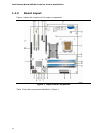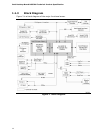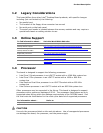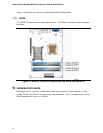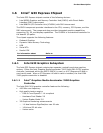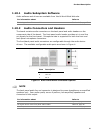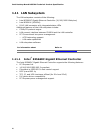Intel Desktop Board DG33BU Technical Product Specification
20
• Video
⎯ Software DVD at 30 fps full screen
⎯ DVMT support up to 256 MB
• Display
⎯ Supports analog displays up to 2048 x 1536 at 75 Hz refresh (QXGA)
⎯ Dual independent display support
⎯ DDC2B compliant interface with Advanced Digital Display 2 card or Media
Expansion Card (ADD2/MEC), support for TV-out/TV-in and DVI digital display
connections
1.6.1.2 Dynamic Video Memory Technology (DVMT)
DVMT enables enhanced graphics and memory performance through highly efficient
memory utilization. DVMT ensures the most efficient use of available system memory
for maximum 2-D/3-D graphics performance. Up to 256 MB of system memory can be
allocated to DVMT on systems that have 512 MB or more of total system memory
installed. DVMT returns system memory back to the operating system when the
additional system memory is no longer required by the graphics subsystem.
DVMT will always use a minimal fixed portion of system physical memory (as set in the
BIOS Setup program) for compatibility with legacy applications. An example of this
would be when using VGA graphics under DOS. Once loaded, the operating system
and graphics drivers allocate additional system memory to the graphics buffer as
needed for performing graphics functions.
NOTE
The use of DVMT requires operating system driver support.
1.6.1.3 Configuration Modes
The video modes supported by this board are based on the Extended Display
Identification Data (EDID) modes of the monitor to which the system is connected.
Standard monitors are assumed.
1.6.1.4 Advanced Digital Display (ADD2/MEC) Card Support
The GMCH routes two multiplexed SDVO ports that are each capable of driving up to a
225 MHz pixel clock to the PCI Express x16 connector. When an ADD2/MEC card is
detected, the Intel GMA 3100 graphics controller is enabled and the PCI Express x16
connector is configured for SDVO mode. SDVO mode enables the SDVO ports to be
accessed by the ADD2/MEC card. An ADD2/MEC card can either be configured to
support simultaneous display or can be configured to support dual independent display
as an extended desktop configuration with different color depths and resolutions.
ADD2/MEC cards can be designed to support the following configurations:
• Low Voltage Differential Signaling (LVDS)
• Single device operating in dual channel mode
• HDTV output



